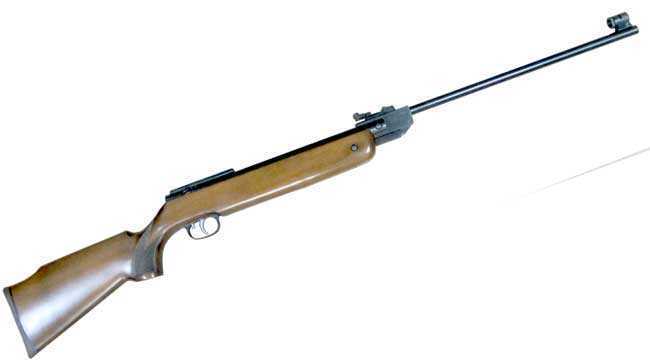
Marksman model 70 breakbarrel rifle.
Part 1
Part 2
Part 3
Part 4
Part 5
Part 6
Part 7
Part 8
Part 9
Part 10
Part 11
Part 12
This report covers:
- Scope test
- The scope
- A soft obstruction
- Sight in
- The test
- Predator Polymag
- Test changed
- Where is the mount now?
- Air Arms 16-grain domes
- Discussion
- Summary
Folks, today I have a special report that taught me many different things. Are you ready to learn with me?
Scope test
Several readers asked me to test this rifle for accuracy with a scope mounted, now that it was shooting both smoothly and powerfully. I wanted to tune the rifle next, but I relented and mounted a scope. And, as long as I was doing that I thought I would also address an issue that reader Pacoinohio has been having with a peep sight walking backwards off his rifle. Oh, boy, do I have a lot of good stuff for you today!
The scope
The scope is one that UTG no longer offers. Boy, am I glad I have one! It is a 2-7X44 Mini SWAT with long eye relief. It’s clear as a bell and the reticle is as fine as frog hair.
This scope was already in 30mm rings that were shimmed. I felt it would be easy to get on target. But the ring bases are Weaver, so I used the UTG Weaver to 11mm dovetail adaptors. I felt that would show everyone how well this stuff works.
The Marksman 70 has two scope stop holes on the scope base that is screwed to the top of the spring tube. Since the scope has a long eye relief, I put the scope stop in the forward hole.
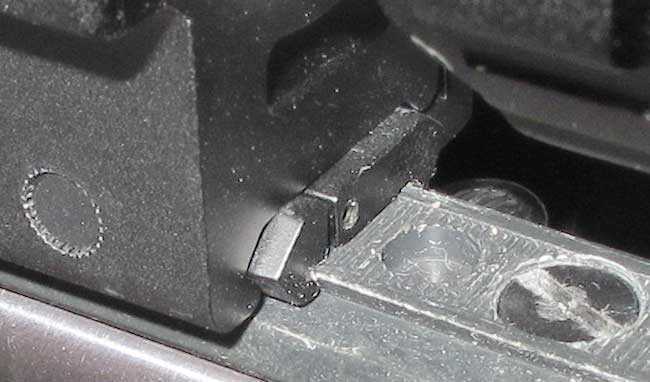
The mount is attached to the rifle’s scope base.
A soft obstruction
I know for a fact that putting a loose steel pin in the stop hole and then sliding the mount back to jam into it will hold the scope and mount rigidly. But I thought that today I would do something a little different. I used a soft-cast .22 long rifle lead bullet instead of a steel pin. This is one of the bullets I cast for the reloading .22 rimfire series, which isn’t finished, by the way. I reckoned the soft lead would give us some idea of how hard that mount is sliding back. After the test we could examine the bullet to see how deeply the mount had dug into it.
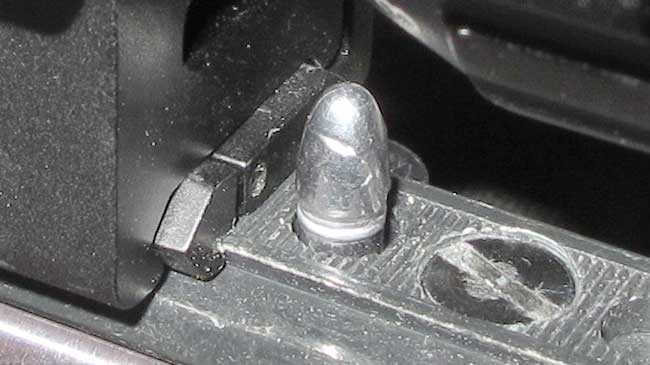
I just dropped the soft lead bullet into the scope stop hole.
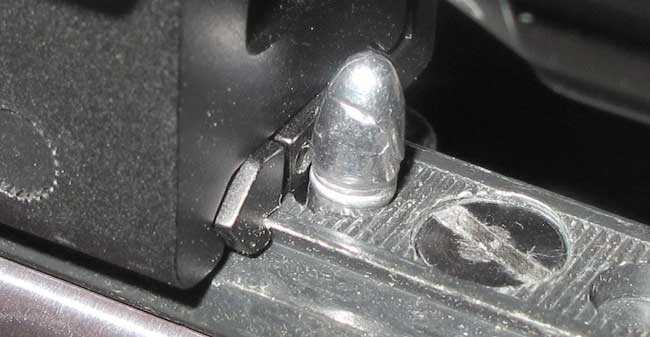
Then I slid the scope back until the rear ring base was jammed against the bullet. Then the scope was tightened on the rifle’s scope base.
Oh, boy! We gonna learn us some stuff today!
Sight in
I sighted in at 12 feet. It took 4 shots to get the scope to the point where I could move back to 10 meters. Then it took another 5 shots to complete the sight-in at 10 meters.
The test
Obviously I am shooting the rifle at 10 meters. I want to keep today’s test close to the test I did in Part 12, so we can make comparisons. That also means I am shooting 5-shot groups. The rifle is rested directly on the sandbag.
The first pellet I tested was the JSB Exact Jumbo Heavy that in Part 12 gave us 5-shot groups that measured 0.357-inches and 0.391-inches Today with the scope five of the same pellet went into 0.461-inches between centers. It’s in the same ballpark as the others that were shot with open sights, but not quite as small. Lesson one is a scope doesn’t always make the rifle shoot better.
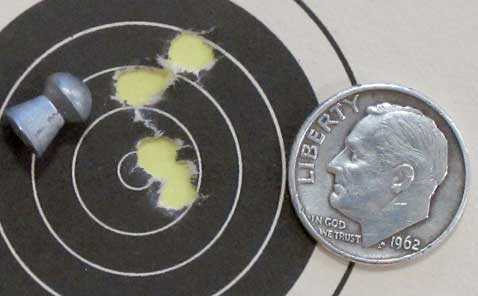
When scoped the Marksman model 70 put five JSB Exact Jumbo Heavies into a 0.461-inch group at 10 meters.
Predator Polymag
The next pellet I tested was the 16-grain Predator Polymag. In Part 12 I shot three 5-shot groups with these. They measured 0.431-inches, 0.552-inches and the third was 0.639-inches. Today he first four pellets went into 0.334-inches. On shot number 4 something fell off the rifle and landed on the shooting bench. The soft lead bullet I had placed in the scope stop hole had sheared off! Shot five opened the group to 0.727-inches.
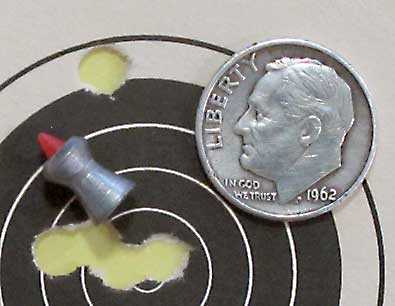
The first four pellets made a 0.334-inch group and then shot five, shot after the bullet sheared off, opened it to 0.727-inches.
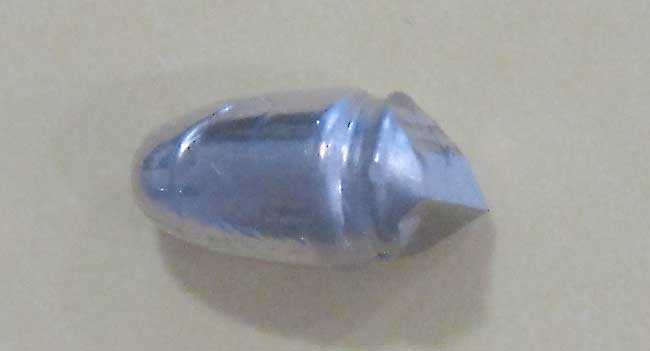
Look how cleanly the bullet was sheared from the scope mount sliding backwards under recoil!
So, the nine sight-in shots plus the five shots in the first group and the four in this group (another nine, for a total of 18 in all) were what it took to shear off that .22-caliber lead bullet. That’s a lot of force when you think about it.
Test changed
Well, we got us a brand new test with this turn of events. There is no way I can continue to run this test and call it right. And as far as I’m concerned the first group is not valid either, since the mount was moving while it was being shot. So, I decided to make some lemonade!
Where is the mount now?
I photographed the mount base before the last 5-shot group.
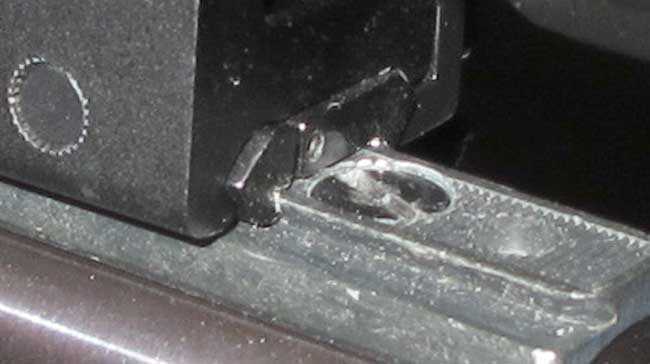
This is where the scope mount is before the last 5 shots.
Air Arms 16-grain domes
I had two more pellets to test with this rifle, but because of what happened I only shot one of them. I have run out of .22-caliber RWS Superdomes and when I tried to order them a few weeks ago they were out at Pyramyd AIR. I bought three tins today, but we will have to wait for them to come to me. So instead I tried that Air Arms 16-grain dome.
Five of them went into a group measuring 1.196-inches between centers. But look at how low they hit! And take a look at the scope mount after those five shots.
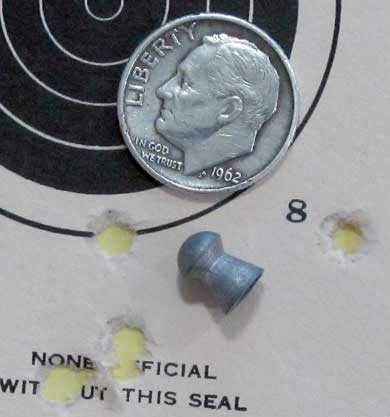
Five Air Arms domes dropped below the bull and went into a 1.196-inch group.
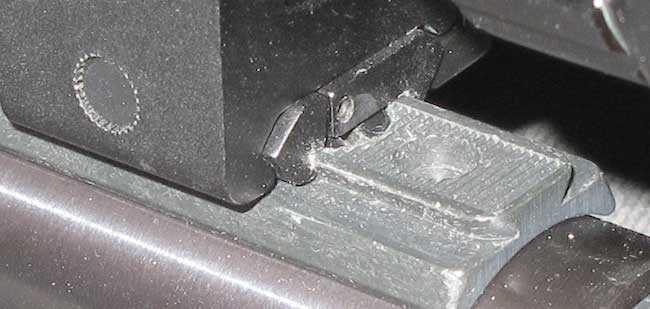
After five shots this is how far the scope mount slid.
Discussion
Well, we certainly learned a lot today! First we learned how much force a sliding scope mount has. It can shear a solid lead cylinder.
As a corollary to that lesson this report should show that if you do use my steel pin idea, go as large as possible (as close to the scope stop hole’s size) to spread the force. A thin bar in the hole of this rifle would probably leave dents in the side of the stop hole.
Next, I hope we learned that a scope doesn’t always make an airgun more accurate. Of course that lesson won’t be completed until I can run this test again without the scope moving. So I better hold off making pronouncements.
Finally, I hope the last two pictures that show how much the scope mount moved in five shots demonstrate the need for a scope stop.
Summary
I had planned to run this test once and then move on to tune the rifle. But with what happened today I definitely need to re-run today’s entire test. We’re getting to see this Marksman model 70 quite a lot, aren’t we?


Did you properly torque the thing down? I’ve had rails move, but never that much even on a d350 that tossing 30+fpe.
Edw,
Yes, the scope bases were tightened.
BB
How tight do you have to tighten these things, and how do you measure that? By how white your knuckles get, or by how red your face gets? I’m kidding of course, about the last bit, sort of.
Roamin,
Except for BKL mounts the tightness is of little concern. You need a solid mechanical stop if you have a problem like what you see in today’s report.
BB
Roamin
Keep reading on down.
You will get what your looking for.
Thank you, B.B. and Gunfun1, I think.
Roamin
No problem.
BB,
Maybe some BKL (dovetail) rings (such as BKL 263) would hold the scope better than Weaver rings with an adapter. In your June 6, 2019 report you said:
“I have never heard of any BKL rings that are properly installed moving on any spring rifle, let alone one that is as smooth as the HW50.”
/blog/2019/06/aligning-a-scope-with-the-axis-of-the-rifle-bore/
See video at 3:00 for pre-bending the rings for a tight fit.
https://www.youtube.com/watch?v=5bRTFNYBIkw
Don
Don,
BKL would solve the problem. But I was trying to help someone who doesn’t own BKL rings.
BB
B.B.,
Up until just now I have been too cheap to spluirge for BKLs. Not now, however. I have to get shopping! (Any specific recommendations from the BKL ring lineup?)
Michael
Michael,
Get the size mounts you need. And get 2-piece over one.
But there are some things to know about. First, some dovetails like the Diana 27, are very narrow and BKLs may not fit. A call to AirForce could clear that up hopefully.
Next, it is possible to over-tighten BKL base screws and strip them. I have done it a couple times. As I said, thightness isn’t the issue.
BB
B.B.,
The Diana 27 often has that thin “landing strip” welded to the top of the tube, providing shallow side grooves and perpendicular “speed bumps” for mounting the old Diana aperture sight. Is that what you are referring to?
Michael
Michael,
Don’t know if you’re considering mounting a scope on your Diana 27 but…know the rail on your 27 isn’t designed for a scope. Many mounts with extreme clamping pressure, like the BKL’s, will pry that rail right off your gun after very few shots.
The other problem is that there isn’t a true scope stop hole on the 27.
Kevin,
I do not intend to ever put a scope on my 27. I do have a vintage Diana aperture sight mounted on it, which is what I believe that thin strip is designed for. It works out very well for me in my backyard. :^)
Michael
BB I got cheap simmons mounts cut the ring off so just the base was left and put that behind the rear scope mount as a stop. didnt look great but it worked
BB: Is the Marksman, model 70 rifle extraordinary in it’s recoil power? I feel hardly any recoil movement when shooting my TX200. I also have a Sheridan MB2260, CO2 rifle that has very little movement as well. Now, my 3 pistols, there is some recoil! Orv.
Hoppy,
Nope. This rifle doesn’t seem to recoil that much. But obviously it does.
BB
Doc,
The CO2 rifle does not have the same recoil as a sproinger. A sproinger has an initial rearward recoil as a PCP or powder burner, then it will recoil forward as the piston reaches the end of the compression chamber. It is this forward recoil that causes scopes to walk backward on sproingers and to destroy scopes that are not airgun rated.
Even the TX200 will do this. Special care must be taken when mounting a scope on any sproinger. My Webley/Hatsan Tomahawk has a scope stop that can be mounted in four different positions.
A scope stop is also a good thing to have around sometimes when things just do not line up.
/product/sportsmatch-scope-stop?a=7860
B.B.,
Come on Tom I’m calling you out on this one! LOL!
The shear strength of Aluminum is 6 times that of Lead and Mild Steel is at least 17 times that of Lead.
HIGH NOON at the OK Corral with water pistols!
Red dye in the water!
shootski
BB-
I have a peep sight that is moving backwards?
Paco,
If it isn’t you I apologise. It gets busy here! 🙂
BB
Me too. I am strongly considering having the base of the peep sight drilled and tapped for a scope stop pin screw by a local gunsmith. But I am wondering if the metal of the cheap peep is strong enough.
Roamin Greco,
What I found out that really matters a lot is the mass of the sight. Of course a scope weighs more. Your peep sight is it made of aluminum or steel? When we modified a rear sight into a peep we made the mistake of making the disc out of thick steel instead of sheet steel which made all the difference. It proceeded to not only walk but also batter the flat steel spring inside into submission subsequently breaking it.
Siraniko
I know this late, but this is for Siraniko, pacoinihio, B.B., and Gunfun1, and anyone else that wants to chime in. Here are some pictures. My Beeman R7 has two stop pin holes.
Roamin Greco,
Dissolve a little rosin powder in acetone or alcohol then brush it on the gripping surfaces of your sight jaws and dovetail. Once the rosin carrier evaporates you will have a THIN layer of rosin on the mating surfaces. Polish off any excess with soft cloth and very light pressure.
I use a soft fine pointed watercolor brush for application as well as a dry brush to polish off the excess.
shootski
My AirVenturi peep sight has to sit with the “box” hanging over the back of the spring tube, or the bottom of the box will prevent the dovetail clamp from engaging the dovetail at all. This also puts the aperature closer to my eye. But I can’t put a pin or screw behind the box if you can see what I mean.
By the way, I reversed the image of the peep, just to orient it in the same direction as the rifle.
The only part of the peep that is magnetic is the sheet metal that surrounds the top, back, and bottom of the box, and the screw and the part that grips the one side of the dovetail. The sides of the box and the base are not magnetic. But there seems to be room to drill and tap for a scope stop pin through the base of the peep.
Roamin Greco,
Degreasing the dovetail and putting rosin in between the rail and dovetail is all I can think of short of drilling and installing a properly sized stop screw/pin in the front that will fit snugly into the rearmost stop pin hole.
Siraniko
Thanks, Siraniko and Shootski. I was looking around for rosen powder and I found that it is used to absorb moisture. That sets off red flags. Do you ever find rust under the mounts where you applied the powder? Next, what do you degrease the raiIl with? Finally I always wipe down my guns after shooting them with Ballistol. Any concern that the oil will wick under the clamp and into the rosen and lubricate the whole works?
I had a RWS peep site on a model diana 48 and the stop screw gouged a channel in the aluminum base. the 48 destroys scopes and even the peep site
Paco
Show a picture of your sight on the gun at different angles.
I had a Williams peep on one of my 30’s with a Gerhman adjustable aperture. Had no walking or sighting problems.
Only problem I had was my eye’s.
BB,
If you notice the small slots in the top of the rail, they are to engage the slotted foot in the old peep sights. As for the rail itself, you will likely find it is more narrow than most rail slots on the more modern air rifles. Of course you likely know all of this, but many do not.
RG,
Before you attempt to drill and tap the peep, find a steel pin or screw that will go into the stop hole relatively snuggly and try using it as BB did the lead bullet. It may be under the clamp but still engage the clamp itself at some point.
I myself have the same concern with my Williams peep walking on my HW30S. I will find a pin to fit in my stop hole. I had an old FWB peep walk off of the HW30S already.
RR, see above. I don’t see where a pin would engage the peep without some mods. If the peep is too far forward 1, the peep won’t engage the dovetail and 2 I won’t be able to see anything through the peep unless I remove the aperature and use it as a ghost ring. In that case, I may as well get the Williams or stop waiting for P.A. and get the Airforce peep direct.
B.B.
This just begs the question, “Why do not springer gun makers use a Picatinny or Weaver scope rail?”
Problem solved! Even a BKL mount would walk back on that gun.
-Y
Yogi,
Back when this rifle was made the Picatinney base was not that widely recognised. It is today and manufacturers are starting to do what you suggest, but things take time to evolve.
You think a BKL would walk on this base? I don’t know. That might be another good test to conduct.
BB
Yogi,
Both my SIG ASP20 have Picatinny rails. Weaver rails are frequently approximate dimensionally on the width and depth of the cross slots as well as slot fore-aft spacing. That causes the ring(s) to be able to move back and forth in the cross slot. If you have a true to specification Picatinny rail and use true to specification Picatinny rings they will fit within the allowable tollerance with very little or no appreciable space to move fore and aft.
Yes Weaver rings will fit on a Picatinny rail/base but a Picatinny ring will not usually work on a Weaver base/rail.
If that is clear as mud these folks got paid to write theirs:
https://www.brownells.com/aspx/learn/learndetail.aspx?lid=10724
shootski
I agree with Yogi, but would it not vastly help if the gun manufacturers would at least stop the dovetail before the end of the spring tube? Then at least the scopes and peep sights might not walk right off the end.
” The soft lead bullet I had placed in the scope stop hole had sheared off! ”
B.B.,
Wow! I thought I might have been a bit excessive when I drilled and tapped my last scope mount for two 1/4″x28 steel set screws to be used as stop pins (with corresponding grooves cut into the receiver for the pins to have a firm hold) for a 6X BugBuster scope on a 15 fpe rifle…but I now feel that instead of excessive, it is “adequate” (scope has not moved even a thousandth of an inch after 500 shots). Man, we do learn some cool stuff on this blog! =>
Take care & God bless,
dave
Dave,
We do learn some cool stuff! I’m learning right along with the rest of you! 🙂
BB
*thumbs up* 🙂
When trying to hold a scope in one place on a springer, NOTHING is excessive.
-Y
Yogi, roger that; thank you. 🙂
Doc,
The CO2 rifle does not have the same recoil as a sproinger. A sproinger has an initial rearward recoil as a PCP or powder burner, then it will recoil forward as the piston reaches the end of the compression chamber. It is this forward recoil that causes scopes to walk backward on sproingers and to destroy scopes that are not airgun rated.
Even the TX200 will do this. Special care must be taken when mounting a scope on any sproinger. My Webley/Hatsan Tomahawk has a scope stop that can be mounted in four different positions.
A scope stop is also a good thing to have around sometimes when things just do not line up.
/product/sportsmatch-scope-stop?a=7860
“A scope stop is also a good thing to have…”
RidgeRunner,
“Amen” to that! On my first ever sproinger, an RWS 45, there was a scope stop behind the rear of the scope mount; it was one of the old-style ones, a block that clamped onto the dovetails with a set screw going through it. Being IGNORANT, I said, “What the heck is this thing for?” and took it off. I went to a gravel pit, and put up a target to sight in my [new to me] rifle. I watched through the scope as my pellet hits kept getting higher and higher on the target. On my last shot, the scope (which had been “walking” back but I had not noticed!) walked rigth off the rifle and hit me in the eyebrow! Fortunately, I was young (and dumb) with faster reflexes, so I caught the scope in my hand before it hit the ground.
THAT’s when I realized what the little block I took off was for; and that’s when I learned the wisdom of your comment, “A scope stop is also a good thing to have.” Yep; for sure. 🙂
May your scopes never move,
dave
Michael,
That’s what I’m talking about.
BB
Ok BB it’s time to throw the selector in reverse.
First off my scope hasn’t even moved a smigin on my detuned hw50s. And I got a bigger scope on it with dove tail rings (and NO scope stop).
First thing I’ll say is when I tighten my scope ring clamps to the dove tail on the gun I go back and forth between all the bolts from front to back and back to front and so on till my Allen bolt won’t move no more or I hear and feel a click in the bolt. And of course you have to be carefull so you don’t snap the scope ring clamp.
Next you know those UTG Weaver to dove tail adapters have a set screw that is used as a way to secure the adapter to the dove tail where you want to mount your scope ring.
I call that the fixed side of the adapter. What you do is hold the adapter in place up against the dove tail and then tighten that set screw. Then you take the side of the Weaver scope ring fixed side on that side of the UTG adapter. Then you take the clamp side of the ring and place it over the UTG adapter and tighten it up pretty tight. I have used those UTG adapters on magnum springers with no movement after setting them up like I just described.
I like those UTG adapters and have had no problems with scope walk on springers. Even on the Diana 54’s that I tried those adapters on.
GF1,
Yes I am aware that the UTG Weaver to dovetail adaptors have a scope stop screw. But it is tiny and could lead to the denting I talked about in the text. That’s why I didn’t use it.
BB
B.B.,
Understand your reason for your mount stop pin test using your soft lead bullet given the recent discussions on the blog.
Just for clarity, doesn’t the 11mm to weaver adapter you used have a scope stop pin built in that could be adjusted downward to fit into the receiver hole?
Kevin,
Yes I am aware that the UTG Weaver to dovetail adaptors have a scope stop screw. But it is tiny and could lead to the denting I talked about in the text. That’s why I didn’t use it.
BB
B.B.,
Thanks for the clarification. Never used the UTG adapter. Always used the Hawke. Sent you one of the Hawke adapters with the stop pin resized for a test you were doing years ago. Shame that the stop pin on the UTG is too tiny to be useful. I learned something. Thanks
Kevin
As it always goes. The set screw in the UTG weaver to dove tail adapter can hit the receiver hole depending on how big the diameter of the stop hole is in the action..
And I turn the set screw around and start it from the other side of the adapter for it to work how I use the UTG adapter.
Here’s the picture. I just don’t know why they show the set screw going through from that direction. The Weaver crosbar locks the scope ring to the notch in the UTG adapter.
BB
Tit for tat.
One way or the other if you use a scope stop be it the set screw in the UTG adapter or a scope ring. There will be a mark left.
Think about it. If your springer is still hitting that hard and you have something going inside the springers action it will start making a round dent in that reciever action hole.
And a big note. If you tighten down the rings on a dove tail with a action tube stop or a small indentation from the UTG set screw like I explained the scope ring should not move and make marks. Well other than the contact point. Will you ever get away from that?
Now guess what. The next problem. The scope shifting back in the ring saddle. You want to know what my solution of scope walk is in the ring saddle. A drilled and threaded hole in the top scope ring cap with a set screw with a point on it. You tighten the set screw in the top cap after your scope is set up.
Trust me that scope is going no where if you do all that. Well I guess I shouldn’t say that. Somebody will try it on a uber high velocity piston slaming light weight pellet shooting springer and wonder why the scope moved.
And yes I know this. The rings can’t always be placed in the right spot to use the turret housing or the objective bell to hold the scope in the rings.
Scope mounting is not a simple thing if you want to do it right.
GF1,
Thanks for your insight into these 2 piece adapters. Reversing/Switching the stop pin so the larger portion contacts with the stop pin hole on the receiver makes sense.
I’ve been forced to use the Hawke one piece dovetail to weaver adapters on older springers that had short dovetails. The old hawke one piece adapters have great clamping pressure from both sides and could also compensate for droop.
Normally I don’t like “layer caking” a scope mounting system but was forced to on these guns.
I disagree with, “One way or the other if you use a scope stop be it the set screw in the UTG adapter or a scope ring. There will be a mark left.”
You can eliminate marks in or around your scope stop hole on your receiver by making sure the stop pin fits/fills the receiver hole and is deep enough. On over size scope stop holes on a receiver I’ve used steel tubing (bought from hobby stores), cut to proper length, that fit the hole fully and surround the stop pin on either the adapter or scope ring.
You drill and thread a hole in the top scope ring cap with a set screw with a point on it that then contacts the scope body??!!
Seems like a good way to etch a scope tube LOL!
Kevin
I like the idea of putting a piece of tube in the stop hole.
And try the set screw in the top of both rings and see what you find out. I guess use a scope that don’t work and just shoot a bunch into your target stop and see what happens. Let us know if you try it.
Kevin
No the UTG scope ring adapter BB used does not go in the stop hole on the springer action. It is off set to the side in the UTG adapter. The sets crew hits the top of the reciever. It will never hit the receiver hole in the spring gun action.
I’ll see if i can find a good picture to post of the off set set screw. In the adapter.
Read my other reply.
I couldn’t edit. Time done expired.
The set screw can make it into the scope stop holes on some guns if mounted like I said with the solid and flexible clamp in the correct position on the UTG adapter.
B.B. and Readership,
I have a question for you and that is, why shouldn’t I put the scope stop block behind the front scope ring? I don’t see a real reason why I should only put it behind the rear scope ring, but that is what others have done and I notice that all scope stop holes that are bored into the receiver of a springer that I’ve seen are located for the rear ring to engage with it.
It would be handier for me to anchor the front ring for better eye relief and for me to use medium rings for a more comfortable cheek weld.
Do you think it makes any difference which ring I anchor? Thanks for the help.
Will
Will don’t know what scope stop your using. But usually they have a set screw also that goes in the hole of the receiver. So it would work best on the rear scope ring also.
Will,
If you can put it there it makes no difference. It works just as well. The reason the back ring is used most often is that is where the stop holes are located.
BB
B.B.
Alright, thanks very much! I thought this would be the best place to ask.
GF1. there is no hole in the receiver.
Will
Will
Oh ok.
BB
I had to go back and look.
This is not the right way to position the UTG adapter in the scope ring like how you did in this picture I screen shot.
The movable small-side of the adapter should be on the same side as the movable clamp on your scope ring for the adapter to work right. For it to clamp more secure to the dove tail on the gun.
GF, Great catch, “eagle eye”. – Don
Don not really with the eagle eye.
I just know what way these adapters work.
Found all this out the hard way as usual.
I learned a lot of new things from the discussion above. Thank you to all.